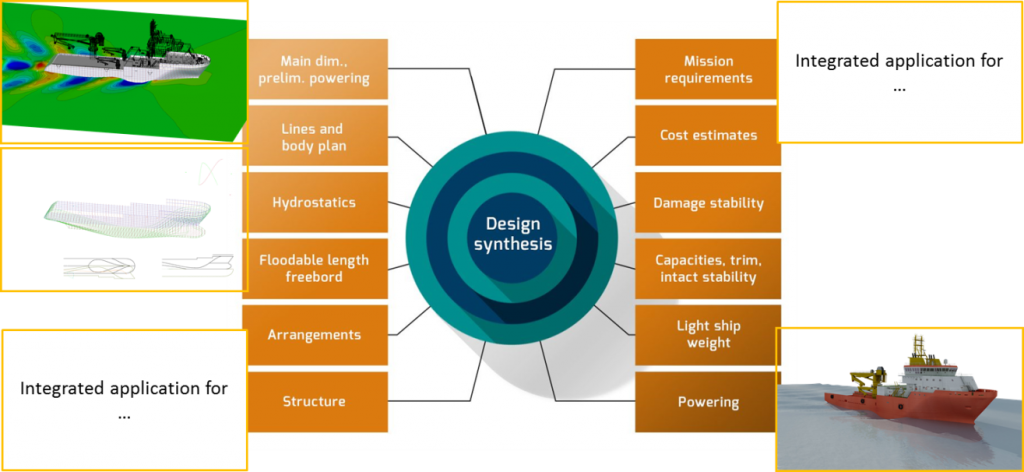Started in September 2016, HOLISHIP is a research and development project of 40 European partners from the maritime industry, research institutes and universities.[1] Funded with a grant of 11.3 M€ by the Horizon 2020 Transport Research Programme of the European Union, the project aims at developing the next generation of flexible systems for the design and performance assessment of ships. HOLISHIP – which stands for “HOLIstic optimisation of SHIP design and operation for life cycle” – addresses the growing aspiration of the European maritime industry to take a holistic approach to design and operation of maritime assets.
The project is organised in three clusters: Cluster 1 comprises work packages for improving methods and tools needed at all stages of design and operation, ranging from market analysis and system architecture via hydrodynamics and structures to machinery and Life-Cycle Cost assessment. Cluster 2 is devoted to integration platforms for Computer Aided Engineering, including optimisation, and virtual demonstration of vessel performance. Finally, cluster 3 brings together application cases that will utilise results from clusters 1 and 2, covering for instance RoPAX and double-ended ferries, cruise ships, OSVs and research vessels.
For Computer Aided Engineering (CAE) within cluster 2 the process integration and design optimisation (PIDO) system CAESES® by FRIENDSHIP SYSTEMS was selected to form the basis of what is called the “HOLISHIP Platform.” The virtual vessel demonstrator within cluster 2, meanwhile, will be based on RCE by DLR as a workflow engine.
CAESES® enables the coupling of tools and systems across platforms, provides parametric modelling and offers algorithms for design exploration and optimisation. The geometric modelling capabilities within CAESES® focus on simulation-ready CAD (Computer Aided Design). They are commonly utilised for simulation-driven design in ship hydrodynamics as well as in fluid-thermodynamics of turbomachinery and engine components.

Taking a holistic approach to design, many tools and systems from all disciplines need to be combined as shown in Figure 1. While the well-known classical view of the design spiral (as introduced by Evans) suggests an iterative approach, refining knowledge and information over time, the design synthesis emphasises the dependency of systems and components, showing that relationships are multi-lateral and should be taken into account concurrently.
By being able to analyse and assess many design variants at a time, the potential of identifying better solutions increases substantially. The overarching idea is to study many variants, rather in the range of hundreds than dozens, at both the concept and the contract design stages. The aim is to come up with proposals that are best compromises with regard to objectives such as energy efficiency, seakeeping behaviour, structural integrity and weights, safety, operational flexibility etc.
Several academic projects have proven so far that, in principle, a sophisticated synthesis model can be created and applied successfully. Examples were published for the holistic design of tankers, container ships and ferries, see for instance Papanikolaou et al. Within HOLISHIP the next step shall be taken, namely making the holistic design approach available to naval architects and designers at shipyards, design offices and consultancies. The challenge is to bridge the gap of tool specific expertise, for example in running a viscous flow solver, and the general system know-how required for designing a complex ship. In other words: Tools and systems need to be made available such that a wider group of engineers can benefit more easily and faster. HOLISHIP strives to create this environment for design synthesis, open for both tool providers and users in the future.
Further details can be found at http://www.holiship.eu. For information on CAESES® see www.caeses.com.
 HOLISHIP is being funded by the European Commission within the HORIZON 2020 Transport Programme.
HOLISHIP is being funded by the European Commission within the HORIZON 2020 Transport Programme.
[1] HSVA (coordinator), ALS Marine, AVEVA, BALance, Bureau Veritas, Cetena, Center of Maritime Technologies, Consiglio Nazionale delle Ricerche, Damen, Danaos, DCNS, DLR, DNV-GL, Elomatic, Epsilon, Fraunhofer-AGP, Fincantieri, Friendship Systems, Hochschule Bremen, IRT SystemX, Institute of Shipping and Logistics, Lloyd’s Register, MARIN, SINTEF, Meyer Werft, Navantia, National Technical University of Athens, Rolls Royce, Sirehna, SMILE FEM, Starbulk, TNO, TRITEC, Uljanik, Univ. Genoa, Univ. Liege, Univ. Strathclyde, van der Velden